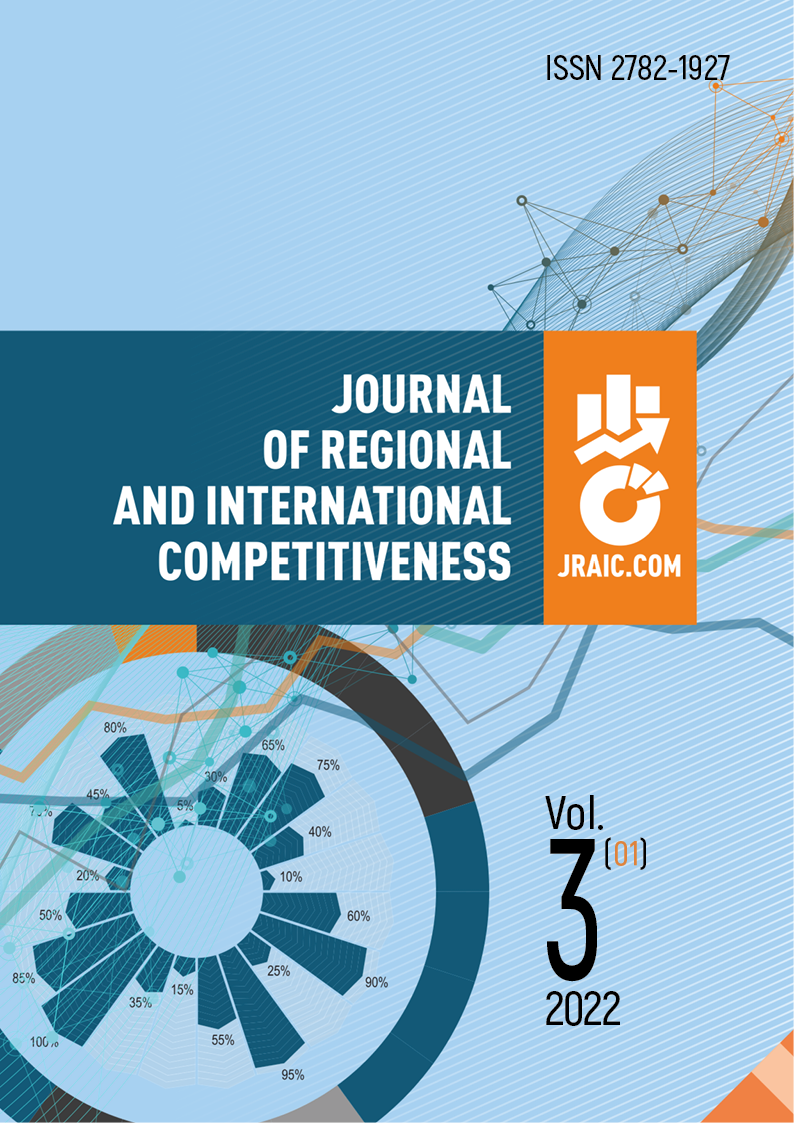Kursk, Kursk, Russian Federation
The competitiveness of the economy is its ability to develop in the conditions of the modern struggle for the new world order. Based on the systems of indicators, the paper assesses the competitiveness of the Russian economy for 2004-2020. The study concluded that its level is decreasing. It proves that the value created in material production underlies the income of the entire society, including the state, and determines the growth rate and the number of people employed in the service sector, as well as in the infrastructure, construction, trade, transport, and communications industries. To accelerate economic growth, it is necessary first of all to increase the growth rate of material production. The obtained statistical dependences make it possible to estimate the volume of investments in fixed assets of material production necessary to ensure a given growth rate of material production and GDP. The paper shows that the Russian economy should do a full re-equipment of production based on modern technology. It has been established that the re-equipment is restrained by the system of relations of capitalist ownership of the means of production, which generates a massive outflow of resources and capital abroad. The study revealed that GDP growth is closely dependent on the growth of new value used within the country. The growth of natural rent in a number of industries has a negative effect, generates instability in the economy development. The technical re-equipment of all industries, primarily engineering, should be emphasized more than the growth of natural resource rent. It has been proved that the state of material production and the use of its results significantly affect not only the standard of living of the population, but also the most important demographic indicators: mortality, birth rate, natural increase of population, and its size. The paper proposes measures to enhance the competitiveness of the Russian economy, which involve a significant strengthening of the role of the state in the development of the economy, including on the basis of state planning.
COMPETITIVENESS OF THE ECONOMY, INDICATORS AND ASSESSMENT OF THE COMPETITIVENESS OF THE RUSSIAN ECONOMY, REASONS FOR THE DECLINE IN THE COMPETITIVENESS OF THE RUSSIAN ECONOMY, THE ROLE OF MATERIAL PRODUCTION, THE NEED FOR TECHNOLOGICAL RENEWAL OF PRODUCTION, WAYS TO INCREASE THE COMPETITIVENESS OF THE ECONOMY, THE ROLE OF THE STATE IN INCREASING THE COMPETITIVENESS OF THE ECONOMY
1. Klinova, M. V. (2020). The state and national competitiveness (case study of the EU). Voprosy ekonomiki, (8), 146-158 (in Russian).
2. Foreign affairs. (1994). Krugman, P. Competitiveness: A Dangerous Obsession. Retrieved from https:// web.archive.org/web/20090123155129/http://www.foreignaffairs.org/19940301faessay5094/paul-krugman/ competitiveness-a-dangerous-obsession.html (accessed 01.02.2022).
3. Jamel, L., Derbali, A., Lamouchi, A., & Elnagar, A. (2021). Trade Openness and Competitiveness: BRICS and Sub-Saharan Africa Countries. International Organisations Research Journal, 16(1), 64–84. Retrieved from https://iorj.hse.ru/en/2021-16-1/458538272.html (accessed 01.02.2022).
4. Gnidchenko, A. A. (2021). Measuring competitiveness by quality: what’s wrong with high-tech exports? Voprosy ekonomiki, (12), 48-65 (in Russian).
5. Federal State Statistics Service. (2021). Russian Statistical Yearbook 2003-2021. Retrieved from https://rosstat.gov.ru/folder/210/document/12994 (accessed 01.02.2022) (in Russian).
6. Finanz.ru. (2021). Russia’s share in global GDP has plummeted to its lowest since the turn of the century. Retrieved from https://www.finanz.ru/novosti/aktsii/dolya-rossii-v-mirovom-vvp-rukhnula-do-minimuma-s-nachala-veka-1030863206 (accessed 02.02.2022) (in Russian).
7. Analytical Center for the Government of the Russian Federation. (2020). Bulletin on current trends in the Russian economy, (67), November. Retrieved from https://ac.gov.ru/uploads/2-Publications/ BRE/_%D0%BD%D0%BE%D1%8F%D0%B1%D1%80%D1%8C_web.pdf (accessed 01.02.2022) (in Russian). 8. Russian Statistical Yearbook, 2001. (2001). M.: Goskomstat (in Russian).
8. Ministry of Natural Resources of Russia. (2021). State Report «On the State and Use of Mineral Resources of the Russian Federation in 2020». M.Retrieved from https://www.mnr.gov.ru/docs/gosudarstvennye_doklady/gosudarstvennyy_doklad_o_sostoyanii_i_ispolzovanii_mineralno_syrevykh_resursov_2020/ (accessed 02.02.2022) (in Russian).
9. Russian Federal Customs Service. Open Data. Retrieved from https://customs.gov.ru/opendata (accessed 20.01.2022) (in Russian).
10. Ministry of Finance of the Russian Federation. Statistics. Retrieved from https://minfin.gov.ru/ru/ statistics/ (accessed 20.01.2022) (in Russian).
11. Bank of Russia. Statistical Bulletin of the Bank of Russia. Retrieved from http://www.cbr.ru/statistics/bbs/ (accessed 20.01.2022) (in Russian).
12. Zamaraev, B. A. & Marshova, T. N. (2020). Efficiency of the investment process of reproduction. Voprosy ekonomiki, (5), 45-68 (in Russian).
13. Finanz.ru. (2022). Capital outflow from Russia sets record since annexation of Crimea. Retrieved from https://www.finanz.ru/novosti/valyuty/ottok-kapitala-iz-rossii-ustanovil-rekord-s-anneksii-kryma-1031110345 (accessed 02.02.2022) (in Russian).
14. Vesti.ru. (2022). Capital outflows from Russia have risen sharply. Retrieved from https://www.vesti. ru/finance/article/2674950 (accessed 02.02.2022) (in Russian).
15. Vesti.ru. (2022) Experts: Russia’s previous sources of GDP growth have dried up, so we need to look for new ones. Retrieved from https://www.vesti.ru/finance/article/2671597 (accessed 02.02.2022) (in Russian).
16. Vodomerov, N. K. (2021). Problems of the Russian economy from the position of traditional Marxism. Theoretical Economy, (3), 39-58. Retrieved from http://www.theoreticaleconomy.ru/index.php/tor/issue/view/3 (accessed 02.02.2022) (in Russian).
17. Klinova, M. V. (2020). The state and national competitiveness (case study of the EU). Voprosy ekonomiki, (8), 146-158 (in Russian).
18. Zehri, C. (2020). Restrictions on Capital Flows and International Financial Institutions’ Support. International Organisations Research Journal, 15(3), 51-71. Retrieved from https://iorj.hse.ru/en/2020-153/412085181.html (accessed 02.02.2022).
19. Naidenova, Yu. N., & Leont’eva, V. V. (2020). Impact of economic policy uncertainty on investments by Russian companies. Voprosy ekonomiki, (2), 141-159 (in Russian).
20. Vlasov, S. A., & Sinyakov, A. A. (2020). Effectiveness of public investment and implications for monetary policy in Russia. Voprosy ekonomiki, (9), 22-39 (in Russian).
21. RBC. (2022). Manufacturers of machinery from Russia have been set the goal of entering the world’s top 5. Retrieved from https://www.rbc.ru/technology_and_media/14/02/2022/62089a019a794702e2673133?from=from_main_6 (accessed 02.02.2022) (in Russian).



















